يمكن تعريف DevOps على أنه دمج أفضل الممارسات الثقافية والفلسفات والأدوات والعمليات لتحسين استقرار المؤسسة لتقديم المزيد من التطبيقات والخدمات بسرعة أكبر.
وهو يتلخص في مساعدة المؤسسات على تحقيق ذلك من خلال زيادة التواصل - التطوير، وعمليات تكنولوجيا المعلومات، وهندسة الجودة، والأمن. عادةً ما تكون هذه الأدوار منعزلة وتميل إلى ممارسة التعاون المتزايد مع تطبيق DevOps.
كما يوحي الاسم، يركز DevOps على الجمع بين التطوير (Dev) والعمليات (Ops) معًا. وهذا يعني أن دورة حياة عملية التطوير بأكملها متكاملة على مستوى الأشخاص والعمليات والتكنولوجيا.
في هذه المدونة، ستتعرف في هذه المدونة على المزيد حول كيفية تبسيط إدارة مشروعك من خلال تطبيق منهجيات DevOps على أعمالك.
ما هي إدارة مشاريع DevOps؟
وفقًا لإحدى الدراسات، بلغ حجم سوق DevOps العالمي 7,398 مليون دولار في عام 2021، ومن المتوقع أن يرتفع إلى 37,227 مليون دولار بحلول عام 2030 بمعدل نمو سنوي مركب كبير يبلغ 20% من 2022 إلى 2030.
مع هذا، ستظل إدارة مشروع DevOps ضرورية لأي مشروع تجاري كبير لإكمال المشروع في الموعد المحدد وفي إطار الميزانية. يستلزم الأمر تخطيطًا دقيقًا, تخصيص الموارد والتنسيق بين العديد من أصحاب المصلحة.
من خلال الجمع بين التطوير و العمليات فرق فريق تكنولوجيا المعلومات في كيان واحد متماسك، يتوسع نهج DevOps في تطوير البرمجيات في أفكار التطوير الرشيق.
على سبيل المثال، يعدل نهج DevOps بشكل أساسي كيفية تتعامل فرق تكنولوجيا المعلومات مع المشاريع من حيث إدارة المشاريع، والابتعاد عن السرعة غير العادية والمطولة في دورة حياة تطوير البرمجيات على المشاريع المعقدة. تم تصميم مزيج من النظامين، وهو إدارة مشاريع DevOps، ليتناسب مع نهج DevOps ويدعمه.
ذات صلة:_
_/مرجع/ https://clickup.com/blog/software-development-tools// أدوات تطوير البرمجيات %/%href/_
فوائد استخدام منهجيات DevOps وإدارة المشاريع ### فوائد استخدام منهجيات DevOps وإدارة المشاريع
تعمل منهجيات DevOps على تحسين العمل الداخلي لشركتك طوال دورة حياة تطوير البرمجيات وتساعدك على تصور عملية DevOps بأكملها، بدءًا من التطوير وحتى النشر. يمكن لمنهجيات DevOps لإدارة المشاريع أن تقود عملك إلى نتائج أفضل وتخلق المزيد من الوضوح لمديري المشاريع وأعضاء الفريق الذين يعملون على نفس المشروع لتحقيق نفس الأهداف.
إدارة مشروع DevOps فعالة للفرق ومديري المشاريع في التعامل مع المشروع بكفاءة. فهي تسمح لمديري المشروع وفرق العمل بتحمل مسؤولية صياغة الاستراتيجية، وتنظيم الأدوات، وتحفيز المهندسين، والتحكم في المشروع بشكل عام.
وهذا النهج المتكامل، يؤثر بشكل مباشر على سرعة التسليم لوحدات العمل المختلفة، مما يترجم إلى سرعة التطوير وتقديم الخدمات وإدارة المنتج على مدار الساعة.
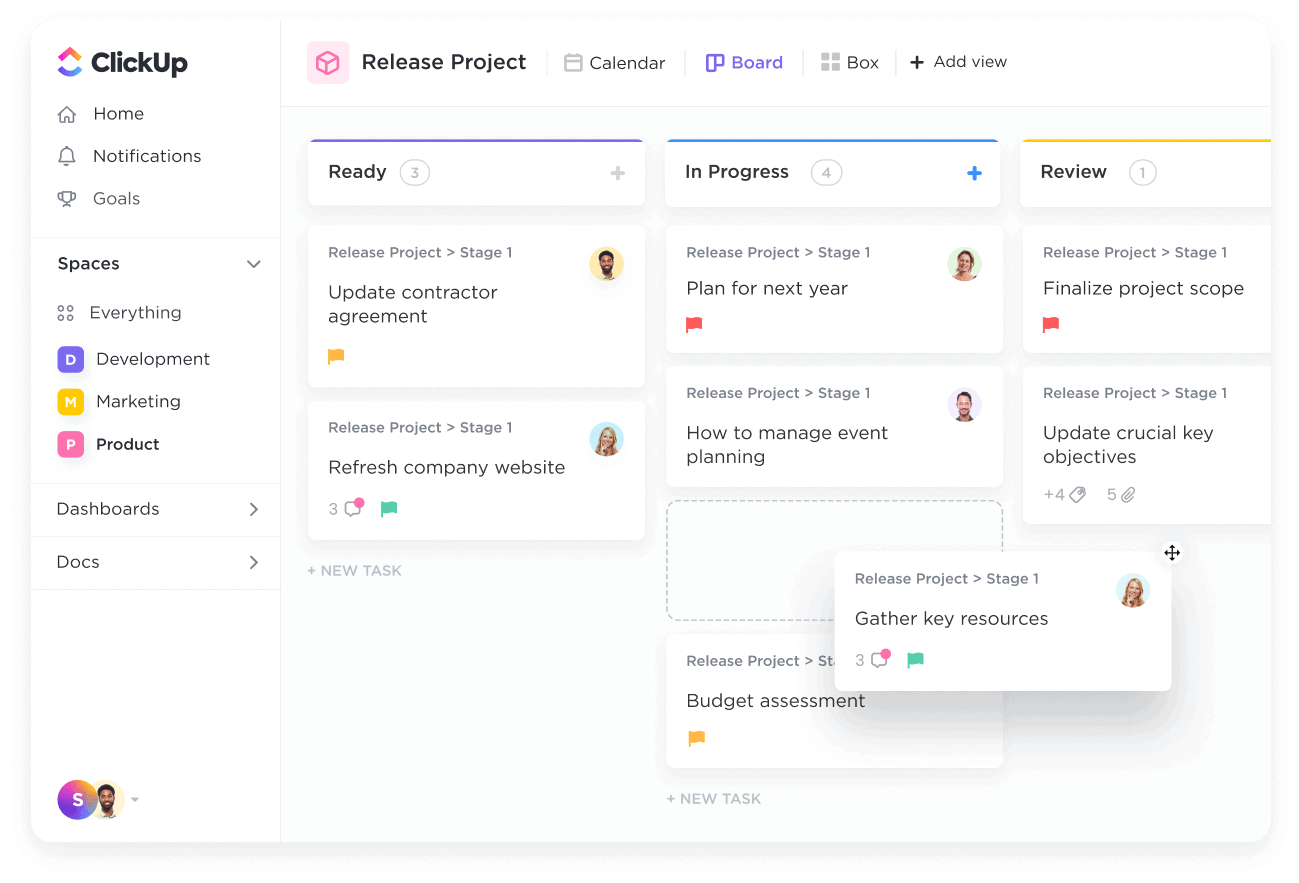
تصور مهام سير العمل الرشيقة باستخدام طريقة عرض ClickUp Board وتعيين اللوحات حسب الحالة وتاريخ الاستحقاق والأولوية والمزيد لمواءمة فريقك بشكل أفضل
يعزز DevOps جوًا تتكامل فيه عمليات المؤسسة وتنسق بشكل أفضل، مما يسرّع من وتيرة تطوير تطبيقات المؤسسات . ونتيجة لذلك، تصبح عملية المؤسسة أكثر كفاءة، وتقل الأخطاء أو تطوير المشروع القضايا.
قد تمنع العديد من الشركات حدوث اضطراب رقمي وتواكب أحدث التطورات وتوقعات المستهلكين المتغيرة بسرعة من خلال الجمع بين تقنيات DevOps والسحابة.
ونتيجة لقدرة DevOps على التكيف، يتم أيضًا تحسين أساليب إدارة المشاريع المستخدمة لمراقبة تقدم المشروع. فهي تدعم مديري المشاريع في مواءمة أهداف تحويل الأعمال مع أهداف مشاريع تكنولوجيا المعلومات، مما يعزز التحسين على مستوى الشركة. لقد حان الوقت للتفكير في المزايا المحتملة لشركتك من ثقافة DevOps إذا لم تكن قد فعلت ذلك بالفعل.
مكافأة:_
_/مرجع/ https://clickup.com/blog/app-development-tools// أدوات تطوير التطبيقات %/%href/
فيما يلي بعض فوائد استخدام إدارة مشاريع DevOps لهذه الأسباب:
- ستتمكن من تعيين الأدوار بشكل صحيح
- يمكن أن يساعدك العمل الجماعي في التغلب على عقلية الصومعة
- يمكنك تتبع حالة المشروع
- الاستفادة من تطبيق السحابة الهجينة
- وأخيراً، يمكنك إنشاء MVP
ما هو دور مدير مشروع DevOps؟
لقد تطورت أدوار مديري المشاريع بسبب منهجية سكروم وغيرها من المناهج الرشيقة. يقوم مديرو المشاريع في منهجية إدارة مشاريع DevOps بالتنسيق بين مختلف المساهمين وتتبع المواعيد النهائية والالتزامات.
كما يجب أن يكون لديهم وعي قوي بعملية التطوير والقدرات المطلوبة لإنتاج المنتج النهائي والعمل عن كثب مع فريق DevOps.
يتحمل مديرو مشاريع DevOps مسؤولية معالجة إدارة وتنسيق المنتج من التطوير إلى الإنتاج. وهم يعملون بشكل أساسي على التفاصيل التقنية، في حين أن مدير المشروع التقليدي لا يشارك في التعامل مع هذه المهام.
ويضمن مديرو مشاريع DevOps إدارة التكامل وتدفق التطوير والاختبار والتنسيق والنشر للمشروع.
التعامل مع فريق التطوير والعمليات كمنظمة واحدة
يتطلب DevOps قائدًا يمكنه مساعدة الفريق في رؤية التدفق من البداية إلى النهاية، تمامًا مثل دور مدير المشروع النموذجي في تخطيط المشروع واكتسابه وتنفيذه. يجب أن يكون إنشاء خرائط تدفق القيمة امتداداً طبيعياً لقدرات مدير المشروع على تخطيط مخطط جانت البياني.
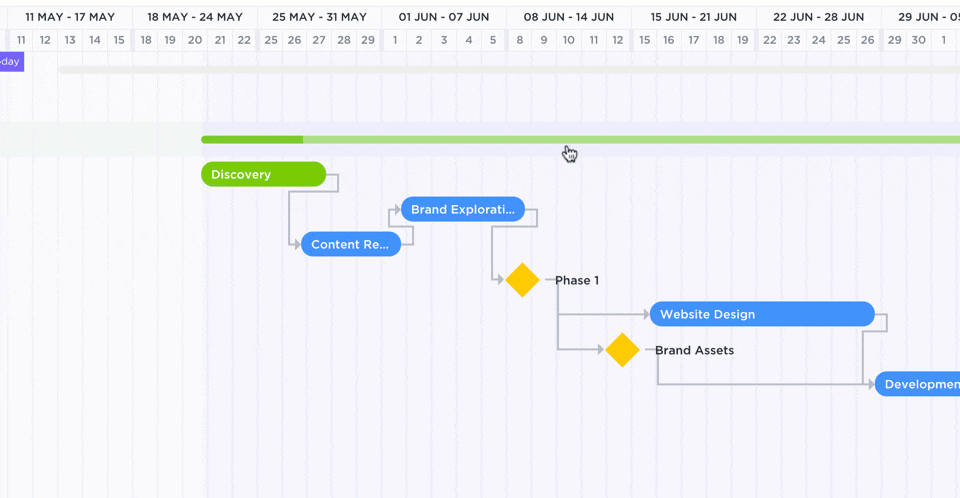
استخدم طريقة عرض مخطط جانت البياني في ClickUp لـ جدولة المهام ومواكبة تقدم المشروع وإدارة المواعيد النهائية والتعامل مع الاختناقات.
من المهم التعامل مع فريق التطوير والعمليات كمؤسسة واحدة لمنع الانعزال في العمل. يتم دمج هذين الفريقين في فريق واحد للعمل عبر دورة حياة التطبيق بأكملها وتطوير المهارات المختلفة، من التطوير والاختبار إلى النشر إلى العمليات.
لن تنجح محاولات استخدام DevOps ما لم تتعاون فرق التطوير والعمليات بشكل أكثر فعالية. ففرق التطوير والعمليات لها تأثيرات عديدة على التعامل مع المهام: تثقيف ومشاركة المسؤوليات بين فريقي التطوير والعمليات وتحسين الإنتاجية والتعاون وفهم مخاطر النشر والوعي بجودة الأدوات وإدارة المهام المضافة.
من المهم أن تظل فرق المطورين وفرق العمليات على اطلاع دائم على آخر المستجدات في جميع الأوقات للتعامل مع هذه التأثيرات بكفاءة أكبر.
تبني التغيير بفعالية
إن إدارة المشاريع الرشيقة توضح المنهجية أن تبني التغيير بدلاً من الالتزام بالخطة أمر بالغ الأهمية. يتطلب الأمر الكثير من التواصل والعمل الجماعي لإدارة التغيير وإصدار الميزات بشكل تدريجي. التواصل هو المهارة الأساسية لمدير المشروع. يجب على الشركات الاستفادة من هذه الإمكانية.
على سبيل المثال، يحتاج مديرو مشاريع DevOps إلى تبني بعض التغييرات من أجل نموهم المهني، مثل البدء في العمل على مشاريع صغيرة، واستخدام نهج MVP، واستخدام أدوات التخطيط الرشيقة المناسبة، والقضاء على الصوامع، وتقليل عمليات تسليم المشروع، وخلق رؤية فورية للمشروع، وتقليل النفقات العامة للمشروع، وإدارة التغيير بشكل تعاوني.

اطلع على أكثر من 15 طريقة عرض في ClickUp لتخصيص سير عملك وفقًا لاحتياجاتك
أداة إدارة المشروع التي يمكن أن تدعم عمليتك الرشيقة، مثل ClickUp ، سيوفر لك الوقت من خلال السماح لك بتتبع العمل والأهداف، وتعيين المعالم، والتعاون في المستندات، وأتمتة الأعمال المشغولة، وتخصيص المهام، وإنشاء حقول مخصصة، وإضافة قوائم مراجعة.
5 أفضل الممارسات لإدارة مشاريع DevOps ## أفضل 5 ممارسات لإدارة مشاريع DevOps
ستساعد التوصيات التالية مديري المشاريع من خلفيات أكثر تقليدية في تبني منهجية DevOps.
1. تطوير ثقافة تعاونية
يعد تحسين التواصل والقضاء على الانعزال بين فرق التطوير والعمليات وضمان الجودة من الأهداف الرئيسية لمنهجية DevOps. يمكن أن يتم تطوير البرمجيات وتسليمها للعملاء بسرعة أكبر باستخدام هذه الطريقة.
يجب أن يتغير موقف الفريق الهندسي بأكمله وعقليته، ويجب أن يكون هناك هدف مشترك أو مجموعة من الأهداف لتحقيق هذه الدرجة من التعاون. اتبع هذه الخطوات لتطوير ثقافة تعاونية مع DevOps:
- إشراك القيادة منذ البداية
- تطبيق الأدوات والتقنيات المناسبة
- مواءمة الأشخاص المناسبين للفريق
- تثقيف الفريق وتدريبه
- تمكين الفريق مع الشعور بالاستقلالية والملكية
- إنشاء نمط من التحسين المستمر والتعلم المستمر
- غرس الشعور بالمسؤولية المشتركة
- إعطاء الأولوية للتواصل المفتوح والشفاف
- إنشاء بيئة من الثقة والاحترام
- مشاركة الأهداف والرؤية المشتركة
2. تبني منظور MVP
يُعرف أبسط تكرار للتطبيق الذي لا يزال يفي بأهداف تطوير البرمجيات الأساسية للمشروع باسم المنتج الأدنى القابل للتطبيق (MVP). ويستخدم لاختبار نماذج الأعمال ويعتبر أفضل مخطط لإطلاق الشركات الناشئة. وهو ليس نموذجًا تقنيًا أوليًا، ولكنه سيساعدك على التحقق من صحة مبيعات عملك.
والغرض الأساسي من MVP هو اختبار فكرة عملك بأقل تكلفة، وإيجاد المزيد من التكرارات للمضي قدمًا في تطوير القيمة، وإيجاد استجابة من الجمهور المستهدف. إذا قمت بإنشاء وظائف كافية، فسيبدأ العملاء في عشق منتجك بسرعة بعد الإطلاق.
تتبنى DevOps عقلية MVP كعقلية لضمان وجود منتج قابل للتسليم دائمًا بعد كل سباق سريع دون التسبب في تأخير تسليمه بسبب النطاق الواسع. ويختلف هذا بشكل كبير عن تقنيات إدارة المشاريع التقليدية التي تشدد على المخرجات المتجانسة النهائية.
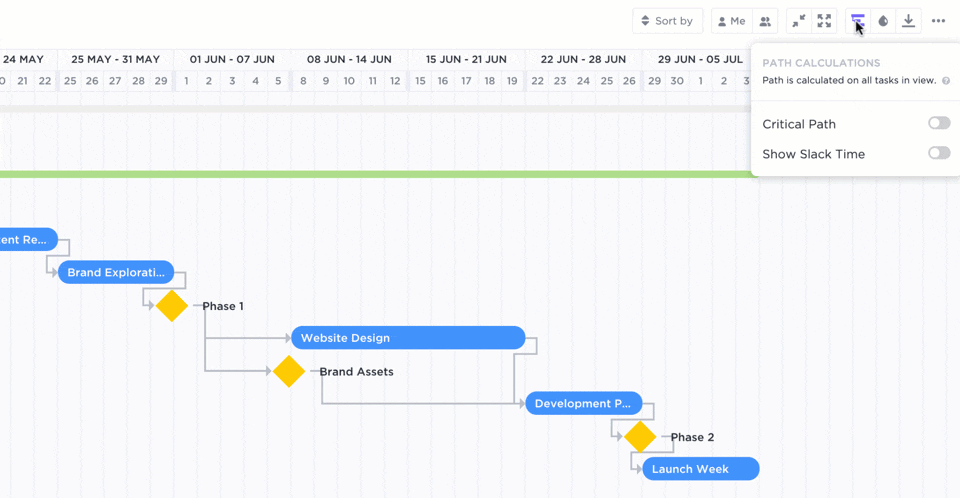
عرض عبء العمل بالمهام المتبقية على المسار الحرج بتبديل واحد في ClickUp!
لا يُنظر إلى DevOps كعملية خطية ذات تواريخ بداية ونهاية محددة مسبقًا بقدر ما يُنظر إليها كعملية تطوير مستمرة. يتلقى العملاء التسليمات بسرعة أكبر مع نهج MVP، ونتيجة لذلك، يمكن لفريق التطوير تصحيح المسار في وقت أقرب في الدورة، وذلك بفضل مدخلات المستخدم.
الفكرة الرئيسية وراء MVP هي تقديم أفضل منتج لجذب العملاء ومراقبة سلوكهم مع استخدام المنتجات والخدمات. وتتمثل الفائدة الرئيسية لهذا النهج في فهم اهتمام العميل بالمنتج وتقديم النتائج المطلوبة.
يمكن لـ MVP إجراء تغييرات على المنتج بناءً على ملاحظات العملاء. يوفر المزيد من الفوائد للشركات للاحتفاظ بالمتبنين الأوائل لمنتجاتها. يعد DevOps و MVP مزيجًا رائعًا لأن الفرق المختلفة يمكنها تخطيط مهامها اليومية بشكل مناسب، وتنفيذ أدوات الأتمتة، والبدء في أتمتة عمليات تكنولوجيا المعلومات، والتواصل بسلاسة مع الفرق.
في غياب ذلك، قد يستخدم فريق DevOps تقنية الشلال لإنتاج المنتج النهائي ليجدوا أنهم لم يلبوا احتياجات المستخدم في نهاية المطاف، وفي هذه الحالة يجب أن تبدأ العملية من جديد.
3. اعتماد التكامل المستمر (CI) والتسليم المستمر (CD)
يدمج التكامل المستمر (CI)، وهو من أفضل ممارسات DevOps المهمة، تحديثات التعليمات البرمجية من مساهمين متعددين في المستودع المركزي. يُمكّن التكامل المستمر المطورين من دمج تغييرات التعليمات البرمجية في كثير من الأحيان واستخدام أدوات آلية للتحقق من دقة التعليمات البرمجية. يُستخدم التحكم في الإصدار للتعليمات البرمجية المصدرية لتنفيذ CI. وتكمن الفكرة وراء التحكم في CI في أنه من الأسهل العثور على الأخطاء ومشاكل الجودة الأخرى في أجزاء صغيرة من التعليمات البرمجية أكثر من قاعدة تعليمات برمجية واسعة تم إنتاجها على مدى فترة طويلة.

عبر DZone حيثما ينتهي التكامل المستمر (CI)، يبدأ التسليم المستمر (CD). والطريقة التي يتم من خلالها استخدام التعليمات البرمجية من التكامل المستمر (CI) هي القرص المضغوط، وهو أحد مكونات DevOps. تصبح عمليات نشر البرمجيات أنشطة بسيطة ومنخفضة المخاطر يمكن للقرص المضغوط القيام بها عند الحاجة.
يمكن لهذا النهج نشر حتى أكثر البرامج واسعة النطاق تعقيداً في عمليات يمكن التنبؤ بها وحسب الطلب.
4. الاستفادة من أفضل أدوات DevOps
تتمحور استراتيجية DevOps الفعالة حول الأتمتة. ويجد المطورون ومهندسو العمليات الذين يعملون في مؤسسة DevOps الأمر أكثر ملاءمة عندما تكون عملية تطوير البرمجيات وإصدارها و الاختبار الرشيق مؤتمتة. DevOps هي برامج سهلة الدمج ومكتفية ذاتيًا للعمل عبر المنصات الرئيسية، وقابلة للتوسيع من خلال المكونات الإضافية، ويمكن توزيعها بسهولة عبر الأجهزة لتسريع عمليات الإنشاء والنشر والاختبارات.
للقيام بذلك، ستحتاج إلى الوصول إلى أدوات DevOps . سواء كان برنامجًا يراقب مقاييس أدائك، أو يصدر تنبيهات عند حدوث أي خطأ أو يوفر رؤية عامة لتطوير منتجك. تعمل أدوات DevOps بسهولة مع AWS و GCP وتبسط عملية الترحيل السحابي. وهي تدعم بشكل جيد ما يكفي لإضافة ميزات وإجراء إصلاحات وأتمتة التحديث وإغلاق التبعية والتبعيات المتعدية.
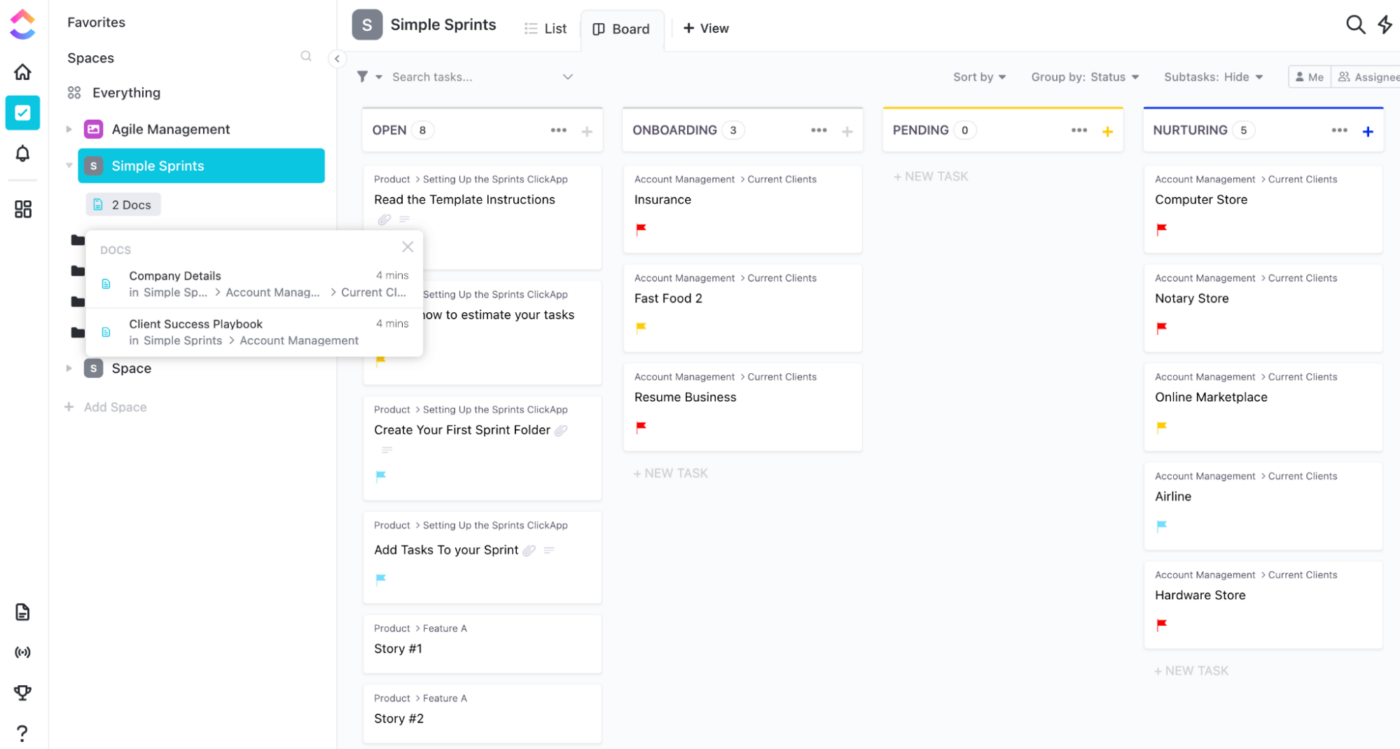
يمكن لفرق العمل الرشيقة أن تشحن بشكل أسرع باستخدام لوحة سبرينتس البسيطة لوحة كانبان قالب بواسطة ClickUp
على سبيل المثال، أفضل منصة إنتاجية لفرق العمل الرشيقة وفرق DevOps هي ClickUp الذي يوحّد جميع الأعمال تحت واجهة واحدة ويتتبع الإصدارات والتعاون السريع. يمكن للمديرين والمطورين والشركاء الخارجيين والأمن والموارد البشرية استخدام ClickUp لتخصيص مساحات العمل الخاصة بهم.
يمكن للفرق استخدام ClickUp كوسيلة رشيقة أداة لإدارة المشاريع لعرض المشاريع من أيام إلى أشهر في المستقبل أو للوصول إلى معلومات مفصلة حول حالة المهمة بسرعة. كما يوفر أيضًا نموذج إدارة المشاريع الرشيقة لمساعدتك في إنشاء سير العمل الرشيق في غضون دقائق. جرب قالب إدارة المشاريع الرشيقة من ClickUp
5. تتبع المقاييس الصحيحة أفضل ممارسات DevOps يوصي بتتبع الأداء المستمر. يمكنك استخدام
أدوات إدارة المشروع مع تقارير تحليلية مدمجة لتمنحك نظرة ثاقبة على البيانات وقدرات تتبع الأداء. باستخدام هذا التطبيق، يجب عليك أيضًا إنشاء لوحات معلومات للفريق لمساعدة جميع المعنيين على تتبع العمل ومؤشرات الأداء والتقدم العام.
تتبع مؤشرات الأداء الصحيحة، مثل الوقت المستغرق، ومتوسط الوقت اللازم لاكتشاف المشكلة، وشدة المشكلة لتقييم فعالية نهج DevOps. يعد تتبع هذه المؤشرات أمرًا ضروريًا لأنه يمكّنك من تحديد المشاكل مبكرًا واتخاذ إجراءات تصحيحية سريعة.
ستحدد أهداف ومعايير مؤسستك مقاييس DevOps التي تحتاج إلى مراقبتها. يمكن لأي فريق هندسة وتطوير أن يستفيد من بعض المؤشرات المرتبطة بالربحية، مثل تكلفة الوحدة.
نظرًا لأنه يمكّنك من تطوير برمجيات فعالة من حيث التكلفة منذ البداية، فإن تتبع تكلفة الوحدة كمقياس لـ DevOps يعد ممارسة ممتازة. وذلك لأن لديك فهم مبكر للتكاليف الخاصة بك، مما يسمح لك بالتخطيط لمبادراتك وإجراء مفاضلات استباقية.
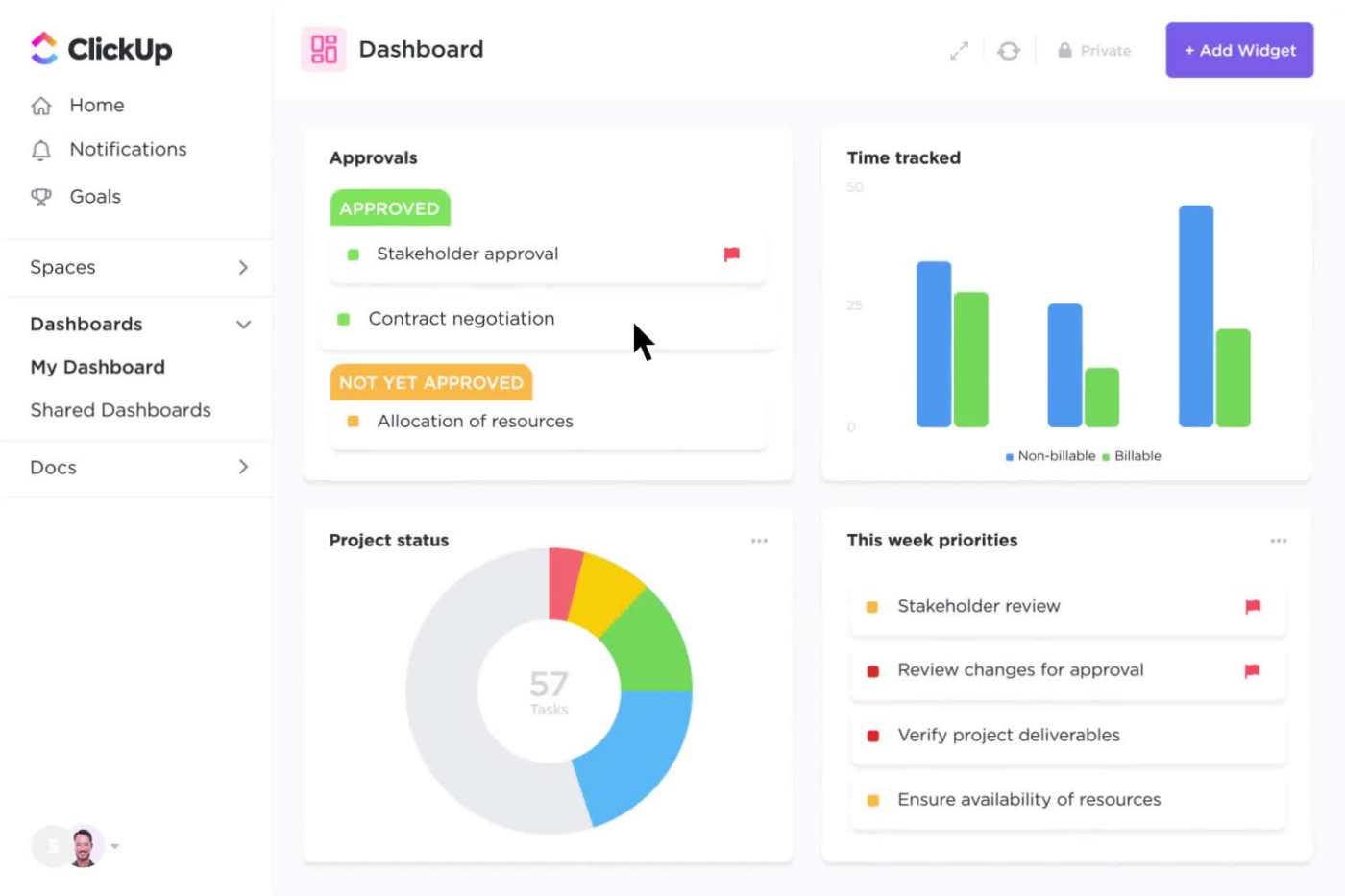
إنشاء لوحات معلومات مخصصة في ClickUp للحصول على نظرة عامة عالية المستوى لجميع أعمالك
حصولك على المزيد من الأفكار والطرق لتحسين عمليات التطوير من خلال قوالب المطالبة بالذكاء الاصطناعي الخاصة بنا .
تنفيذ إدارة مشاريع DevOps: التحديات والحلول الممكنة
دعونا الآن نستكشف بعض العوائق النموذجية التي تحول دون اعتماد DevOps والنهج المختلفة للتغلب على هذه التحديات.
التحدي 1: الانتقال من البنية التحتية القديمة إلى الخدمات المصغرة
حتى لو كانت البنية التحتية القديمة قد خدمت المؤسسة لسنوات عديدة، فقد تواجه البنية التحتية القديمة مشاكل. فقد تواجه مشاكل في الاستقرار بالإضافة إلى نقص التمويل. ويتمثل القلق الرئيسي في أن المؤسسة ستتخلف عن الركب في هذا العالم سريع الوتيرة إذا استمرت في استخدام بنية تحتية قديمة.
تتغير عملية التطوير عند استخدام البنية التحتية ككود وخدمات مصغرة، وهي خطوة أخرى نحو الابتكار المستمر في المستقبل.
فهو يساعد في السوق السريع، ويحتاج المستهلكون إلى التكيف. يمكننا أن نرى أن شخصًا آخر سيتفوق على المؤسسة بسرعة إذا لم تستمر في الإبداع.
قد يكون من الممكن تسريع الابتكار والتطوير من خلال استبدال أو تغيير التطبيقات القديمة ببنية خدمات مصغرة أكثر حداثة. ومع ذلك، فإن اعتماد الخدمات المصغرة ينطوي على بعض المشاكل، ويجب التعامل مع هذه المشاكل.
الحل المحتمل
يجب أن يكون لدى المؤسسة إدارة التكوين واللبنات الأساسية للأتمتة والتسليم المستمر المستخدمة في البنية التحتية القديمة قبل التحوّل إلى بنية الخدمات المصغرة. فهي تمكنهم من التعامل مع الطلب التشغيلي الإضافي الذي تقدمه الخدمات المصغرة.

استخدم وصفات الأتمتة المبنية مسبقًا أو خصصها بناءً على احتياجاتك، حتى يتمكن فريقك من التركيز على ما هو أكثر أهمية
التحدي 2: جعل استراتيجية أتمتة الاختبار حقيقة واقعة
تعرف مؤسستك الدور الحاسم للاختبارات المؤتمتة في التكامل المستمر/التكامل المستمر ### CI/CD ### (التكامل المستمر /_
النشر المستمر_
) وتقنيات DevOps الأخرى. إذن ما الذي يعيق تقدم أتمتة الاختبار؟ بالإضافة إلى تقديم طريقة الاختبار فقط وإعطاء أمثلة على كيفية استخدامها، من المهم مساعدة الفرق. يتم تضمين الطرق الثلاثة وتقنيات BDD، بالإضافة إلى حلول لجوانب أساسية مثل:
- ما هي الطرق التي ندير بها بيانات اختباراتنا؟
- هل يمكننا الاستفادة من المكتبات المشتركة وأفضل الممارسات المفتوحة المصدر؟
- كيف ينبغي تنظيم الاختبار الشامل لقاعدة التعليمات البرمجية الخاصة بنا؟
- ما هي الأغراض الفعلية لاختباراتنا الدخانية؟
الحل الممكن
يمكنك حلها من خلال نشر أتمتة الاختبار في المؤسسة بأكملها، وتقليل حلقات التغذية الراجعة، ويمكن أن يساعدك إطلاق المنتج بشكل أسرع في تعلم كيفية تنفيذ استراتيجية الاختبار.
التحدي 3: اعتماد أدوات جديدة
يبدو أن أحدث الأدوات في مجموعة أدوات DevOps قادرة على التعامل مع أي مشكلة. على الرغم من امتلاك جميع الأدوات اللازمة، إلا أنك لا تزال بحاجة إلى تعليم فرقك كيفية استخدامها بكفاءة.
إن أدوات الإدارة " الالتزام بإرشادات الأمان والتفاعل المناسب مع البنية التحتية الحالية هما العاملان الآخران الأكثر أهمية. هذه القضايا قد تصرف المؤسسة عن مهمة حيوية.
أهم عنصرين أساسيين في DevOps هما الهيكل التنظيمي والفريق. سترتفع إنتاجية الفريق إذا كانت المؤسسة منظمة بشكل مناسب. يجب أن تركز الشركة على نقاط قوتها بدلاً من الموارد الخارجية.
أعضاء الفريق هم العنصر الأكثر أهمية عند التحول إلى DevOps.
الحل الممكن
استخدم أدوات إدارة المشاريع المزودة بميزات للمساعدة في تخطيط المشاريع وإدارتها وتتبعها بفعالية. استخدم قوالب لمساعدتك على البدء/إعطاء فريقك نهجًا منظمًا. عرض جميع قوالب ClickUp
التحدي 4: النفور من التغيير
قد يجد معظم أعضاء الفريق وأصحاب المصلحة الأساسيين أن التحول إلى DevOps غير مريح. قد ينعكس ذلك سلبًا على الشخص الذي يقدم النصيحة نتيجة إخبار شخص ما أنه بحاجة إلى التغيير. سيكون الانتقال إلى DevOps سلسًا وتدريجيًا، ولن يحدث فجأة.
ستتاح الفرصة للجميع لاكتساب ثقافة DevOps تدريجيًا واكتشاف الطرق العديدة التي يمكنهم من خلالها تقديم مرحلة التطوير.
الحل المحتمل
ابحث عن منتج صغير أو جزء من برنامج قائم وقم بتكراره باستخدام تقنيات DevOps كتجربة. سترغب الشركات الأخرى في تطبيق ممارسات العمل الجديدة إذا تمكن الفريق من رؤية مزايا DevOps. ستستفيد العديد من الشركات من دخولها في DevOps وقدرتها على مواصلة العمل في هذا المجال اليوم.
التحدي 5: النهج القائم على الحوافز
في حين أن فريق العمليات يوفر التوافر والحوكمة والأمن والاستقرار، تهدف فرق التطوير إلى تقصير الوقت اللازم للوصول إلى السوق. على الرغم من أن هذا العائق يبدو في البداية غير ذي صلة بالموضوع، إلا أنه يؤثر بشكل كبير على ممارسات DevOps.
الحل الممكن
بدلاً من وجود هدف موحد لإرضاء العميل، فإن الاستراتيجية التنظيمية الأكثر شيوعًا هي أن تركز كل وحدة على مزاياها الخاصة.
إذا عملت جميع الفرق على تحقيق نفس الهدف، فلن يكون هناك أي نهاية للجدل حول الأولويات والموارد .
تنفيذ إدارة مشاريع DevOps بنجاح باستخدام الأدوات والممارسات الصحيحة
يمكنك تحسين تعاون أعضاء الفريق وأهداف التكرار الشاملة من خلال دمج ممارسة DevOps مع أفكار إدارة المشروع.
تعمل أدوات إدارة مشاريع DevOps على تبسيط هذه العملية وتشجيع الرؤية بين مديري المشاريع من خلال ضمان تحديد نطاقات المهام بدقة، وتتبع التبعيات، والحصول على نتائج أفضل، وإنتاج تطبيق جاهز للنشر.
يجب أن يتواصل الفريق للتأكد من أن الجميع على نفس الصفحة ويسعى لتحقيق نفس الأهداف. يمكن لأي منظمة ترغب في الارتقاء بأعمالها إلى المستوى التالي الحصول على دعم احترافي من شركة التحول الرقمي للاستفادة من حلول إدارة مشاريع DevOps للبقاء في المقدمة في الميزة التنافسية.
الكاتب الضيف:

/مرجع/ https://www.linkedin.com/in/madhubalankesavan/ مادو كيسافان /%/%href/
، الرئيس التنفيذي ومؤسس W2S Solutions ، وهي شركة معترف بها عالميًا لتطوير برمجيات المؤسسات. يعمل على تمكين الشركات والحكومات في رحلتها الرقمية. وبفضل عمله لأكثر من 20 عامًا في مجال تكنولوجيا المعلومات، يستخدم التكنولوجيا لتوفير حلول مستدامة. _
